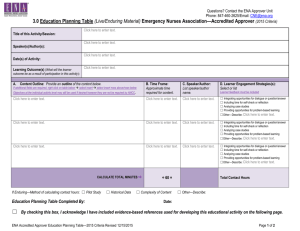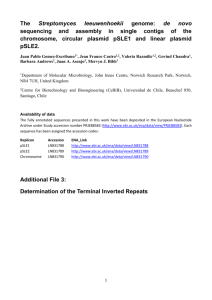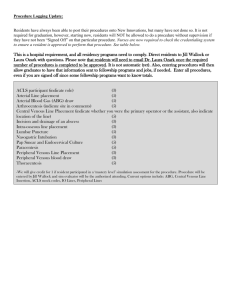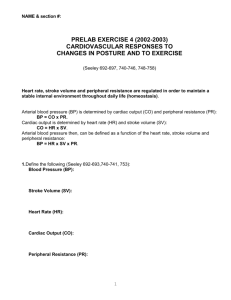ultrasound_resolution
advertisement
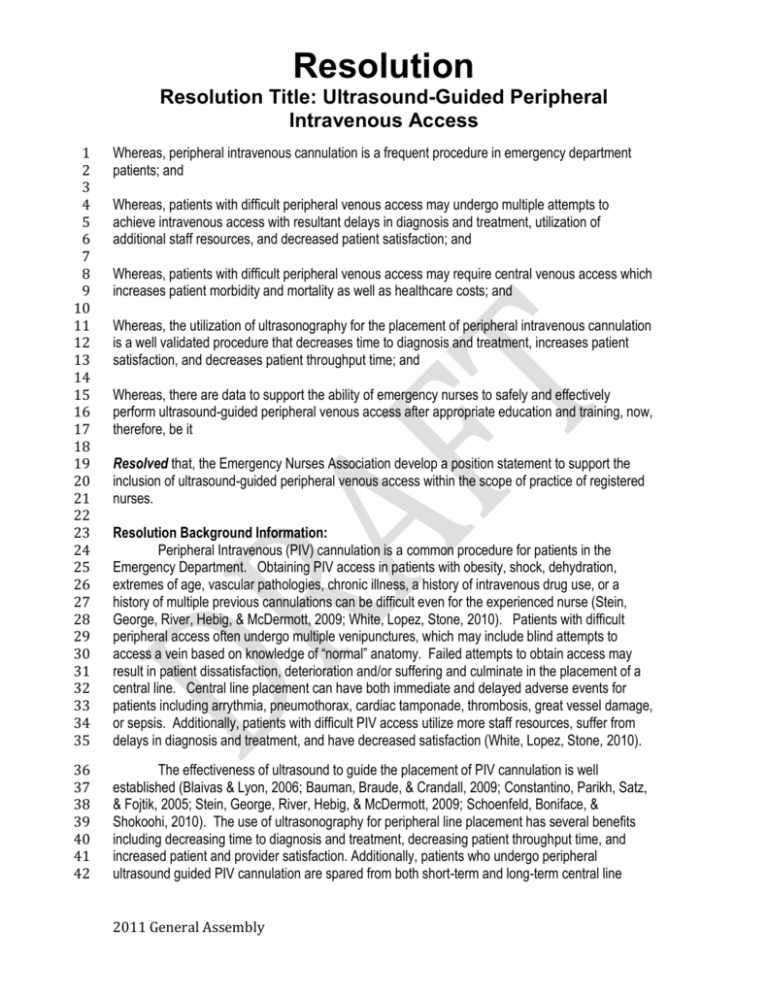
Resolution Resolution Title: Ultrasound-Guided Peripheral Intravenous Access 1 2 3 4 5 6 7 8 9 10 11 12 13 14 15 16 17 18 19 20 21 22 23 24 25 26 27 28 29 30 31 32 33 34 35 Whereas, peripheral intravenous cannulation is a frequent procedure in emergency department patients; and 36 37 38 39 40 41 42 The effectiveness of ultrasound to guide the placement of PIV cannulation is well established (Blaivas & Lyon, 2006; Bauman, Braude, & Crandall, 2009; Constantino, Parikh, Satz, & Fojtik, 2005; Stein, George, River, Hebig, & McDermott, 2009; Schoenfeld, Boniface, & Shokoohi, 2010). The use of ultrasonography for peripheral line placement has several benefits including decreasing time to diagnosis and treatment, decreasing patient throughput time, and increased patient and provider satisfaction. Additionally, patients who undergo peripheral ultrasound guided PIV cannulation are spared from both short-term and long-term central line Whereas, patients with difficult peripheral venous access may undergo multiple attempts to achieve intravenous access with resultant delays in diagnosis and treatment, utilization of additional staff resources, and decreased patient satisfaction; and Whereas, patients with difficult peripheral venous access may require central venous access which increases patient morbidity and mortality as well as healthcare costs; and Whereas, the utilization of ultrasonography for the placement of peripheral intravenous cannulation is a well validated procedure that decreases time to diagnosis and treatment, increases patient satisfaction, and decreases patient throughput time; and Whereas, there are data to support the ability of emergency nurses to safely and effectively perform ultrasound-guided peripheral venous access after appropriate education and training, now, therefore, be it Resolved that, the Emergency Nurses Association develop a position statement to support the inclusion of ultrasound-guided peripheral venous access within the scope of practice of registered nurses. Resolution Background Information: Peripheral Intravenous (PIV) cannulation is a common procedure for patients in the Emergency Department. Obtaining PIV access in patients with obesity, shock, dehydration, extremes of age, vascular pathologies, chronic illness, a history of intravenous drug use, or a history of multiple previous cannulations can be difficult even for the experienced nurse (Stein, George, River, Hebig, & McDermott, 2009; White, Lopez, Stone, 2010). Patients with difficult peripheral access often undergo multiple venipunctures, which may include blind attempts to access a vein based on knowledge of “normal” anatomy. Failed attempts to obtain access may result in patient dissatisfaction, deterioration and/or suffering and culminate in the placement of a central line. Central line placement can have both immediate and delayed adverse events for patients including arrythmia, pneumothorax, cardiac tamponade, thrombosis, great vessel damage, or sepsis. Additionally, patients with difficult PIV access utilize more staff resources, suffer from delays in diagnosis and treatment, and have decreased satisfaction (White, Lopez, Stone, 2010). 2011 General Assembly Resolution Resolution Title: Ultrasound-Guided Peripheral Intravenous Access 43 44 adverse events, which increase morbidity, morality, and healthcare costs (White, Lopez, Stone, 2010). 45 46 47 48 49 50 Multiple evidenced-based articles validate the competency of the emergency nurse in the use of the ultrasonography for PIV cannulation (Blaivas, 2005; Blaivas & Lyon, 2006; Chinnock, Thorton, & Hendey, 2006, White, Lopez, & Stone, 2010). Research has demonstrated that emergency nurses performing ultrasonography for PIV cannulation have placement rates similar to physicians, protect patients from central lines, and decrease the time to diagnosis and treatment (Blaivas, 2005; Blaivas & Lyon, 2006; Chinnock, Thorton, & Hendey, 2006). 51 52 53 54 55 56 57 58 59 60 61 62 63 64 65 66 67 68 69 70 71 72 73 74 75 76 77 78 79 References: Blaivas, M. (2005) Ultrasound-guided peripheral IV insertion in the ED: a two hour training session improved placement success rates in one ED. American Journal of Nursing, 105(10), 5457. Blaivas, M. & Lyon. M. (2006). The effect of ultrasound guidance on the perceived difficulty of emergency nurse-obtained peripheral IV access. Journal of Emergency Medicine, 31(4), 407-410. Bauman, M., Braude, D., & Crandall, C. (2009). Ultrasound-guidance vs. standard technique in difficult vascular access patients by ED technicians. American Journal of Emergency Medicine, 27, 135-140. Chinnock, B., Thorton, S., & Hendey, G. (2006). Predictors of success in nurse-performed ultrasound-guided cannulation. Journal of Emergency Medicine, 33, 4, 401-405. Constantino, T., Parikh, A., Satz, W., & Fojtik, J. (2005). Ultrasound-guided peripheral intravenous access versus traditional approaches in patients with difficult intravenous access. Annals of Emergency Medicine, 46, 456-461. Infusion Nurses Society (2011) Infusion Nursing Standards of Practice. Journal of Infusion Nursing,34, 1S. Schoenfeld, E., Boniface, K., & Shokoohi, H. (2010). ED technicians can successfully place ultrasound-guided intravenous catheters in patients with poor vascular access. American Journal of Emergency Medicine. Advance online publication doi: 10.1016/j.ajem.2009.11.021 Stein, J., George, B., River, G., Hebig, A., & McDermott, D. (2009). Ultrasonographically guided peripheral intravenous cannulation in Emergency Department patients with difficult intravenous access: a randomized trial. Annals of Emergency Medicine, 54, 1, 33-40. White, A., Lopez, F., & Stone, P. (2010). Developing and sustaining an ultrasound-guided peripheral intravenous access program for emergency nurses. Advanced Emergency Nursing Journal, 32, 2, 173-188. 80 81 82 83 Relationship to ENA Philosophy and ByLaws: The mission of the Emergency Nurses Association is to “advocate for patient safety and excellence in emergency nursing practice”. This resolution serves ENA’s the mission by: Defining a standard to serve as a basis for emergency nursing practice; 2011 General Assembly Resolution Resolution Title: Ultrasound-Guided Peripheral Intravenous Access 84 85 86 87 88 89 90 91 92 93 94 95 96 97 98 99 100 101 102 103 104 105 106 107 108 109 110 111 112 113 114 115 116 117 118 119 120 121 122 123 124 125 126 Identifying and disseminating information regarding key trends affecting and pertinent to emergency nursing; and Advocating for effective patient care. This resolution supports the following beliefs from the ENA Code of Ethics: The emergency nurse acts with compassion and respect for human dignity and the uniqueness of the individual. The emergency nurse maintains competence within, and accountability for, emergency nursing practice. The emergency nurse acts to protect the individual when health care and safety are threatened by incompetent, unethical or illegal practice. The emergency nurse exercises sound judgment in responsibility, delegating, and seeking consultation. ENA’s Vision Statement states: “ENA is indispensable to the global emergency nursing community.” This position statement would provide support for emergency nurses seeking to implement evidence-based practice changes to improve care for patients. Financial Considerations: Development of the position statement would be accomplished within the current ENA committee structure. As such, it would incur no additional expenses. Resolution Outcomes: That the ENA develops a position statement supporting the inclusion of ultrasound-guided peripheral venous access in the registered nurses’ scope of practice. This position statement would be available to nurses desiring to implement an ultrasound-guided peripheral venous access program in their institutions. Resolution Authors: Andrew C. Storer, DNP, RN, FNP-C, ACNP-BC, Membership # 505783 Jean A. Proehl, RN, MN, CEN, CPEN, FAEN, 1999 ENA President, Membership # 10523 Michael Spiro RN, MSN, CEN, BSc, Membership # 489746 Kathy Summers-Sitarski, MS, RN, CNS, CEN, Membership #123516 Ann White, MSN, RN, CCNS, CEN, CPEN, Membership # 22940 Sponsors: Arizona State Council Connecticut State Council Delaware State Council Illinois State Council Iowa State Council Kansas State Council 2011 General Assembly Resolution Resolution Title: Ultrasound-Guided Peripheral Intravenous Access 127 128 129 130 131 132 133 134 135 136 137 138 139 140 141 142 143 144 145 146 147 148 149 150 151 152 153 154 155 156 157 158 159 Maine State Council Maryland State Council Michigan State Council Mississippi State Council New Mexico State Council North Carolina State Council Oregon State Council Pennsylvania State Council Tennessee State Council Vicki Patrick, 1981-82 ENA President, Membership # 09821 Linda Larson, 1986 ENA President, Membership # 01951 Margaret M. McMahon, 1987 ENA President, Membership # 10489 Nancy Donatelli, 1988 ENA President, Membership # 8661 Joann Fadale, 1990 ENA President, Membership # 7006 Lynne Gagnon RN, BSN, MS, NEA-BC, CPHQ, 1991 ENA President, Membership # 4609 Eileen Corcoran-Howard, 1993 ENA President, Membership # 722 Renee Semonin Holleran, 1996 ENA President, Membership # 07937 Anne Manton, 1998 ENA President, Membership # 05079 Benjamin Marett, 2000 ENA President, Membership # 17179 Mary Ellen Wilson, 2004 ENA President, Membership # 23035 Patricia Kunz Howard, 2005 ENA President, Membership #25128 Nancy Bonalumi, 2006 ENA President, Membership # 22694 Donna Mason, 2007 ENA President, Membership #75275 Kathleen R. Albert, Membership # 107165 Marlena Dipre, Membership # 227314 Wm. Bryan Gibboney, Membership #446090 Merlann Malloy, Membership #25721 Gerri Muller, Membership # 65449 Anne Stefanoski, Membership # 42141 Mary Alice Vanhoy, Membership # 51004 2011 General Assembly
